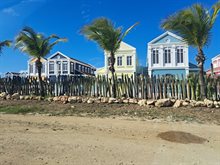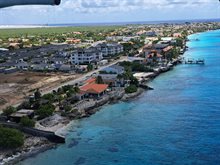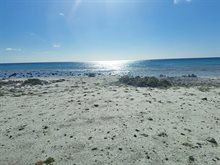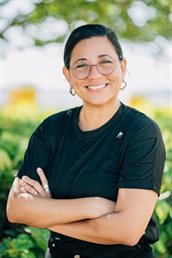Island Voices: Anjelica Cicilia from Bonaire
In the Caribbean part of the Kingdom, climate change is already being felt by people on the islands. It is getting warmer, periods of drought are increasing and when rain falls, much more falls in a shorter period of time. Moreover, hurricanes are becoming more powerful. How should the islands adapt to this? What is happening to prepare the islands and islanders for the future? In the series of interviews ‘Island Voices’, residents from different islands and with different areas of expertise talk about how they view climate change and adaptation.
This time, meet Anjelica Cicilia, commissioner at the Public Entity of Bonaire. Cicilia was born on Bonaire to a Curaçaoan father and a Portuguese mother. After a long career in the Dutch construction and real estate sector, she directs the Directorate of Space & Development in Bonaire since October 2023. Part of her portfolio are Infrastructure & Water Management, Nature, Environment & Ecological Restoration, and Public Housing and Liveable Neighbourhoods.
Want to know more about climate adaptation in the Caribbean islands? On the knowledge portal you will now also find a section on the Caribbean part of our kingdom.
Why are you concerned with climate adaptation on Bonaire?
“Climate adaptation is very important for Bonaire, especially when you look at how fast our island has grown in recent years. We have 25,000 inhabitants and we also have 25,000 cars. But our infrastructure is hardly adapted to this growth. We have a lot of overdue maintenance, including water management. We capture, I think, only five percent of the rainwater. We could do much better. We are therefore working hard to see how we can take into account the changing times with limited resources.”

Are there other climate issues on Bonaire that need to be addressed?
“We are also dealing with drought and heat. Rising temperatures are affecting Bonaire's coral, among other things. Our coral is our island's breeding ground. Bonaire's main income comes from tourism. Visitors often come especially for our nature, but this nature is under pressure. Projections show that the southern part of Bonaire is vulnerable to sea level rise. Therefore, it is important to make climate plans to deal with this. What will we do to counter the negative effects? What does adaptation look like? An important question underneath is: what kind of island do we want to be?”
What does Bonaire need to adapt to climate change?
“First of all, we need data and knowledge. Everything starts with good data, with a good understanding of which areas are really vulnerable and what we need to do about it. We are taking steps and we are professionalizing, but unfortunately we still have very little concrete data. An elevation map is underway, but we don't have one yet. Nor do we have a map that shows all the effects if the climate continues to change. Look, I was trained in the Netherlands and there it is very simple: if you want to make a plan, you first do extensive research. You make an analysis and you look at risks and possible impacts. But on Bonaire that is not as easy.”
You say you are already taking steps to understand the vulnerability of areas. Can you cite an example?
“Recently we have a new project called 'Waterpeilbuizen’ [Water Monitoring Wells] to gain insight into our soil conditions. How exactly do the water flows behave on the island? What is the state is the quality of our groundwater quality? But what we also want to know is: when on average do peak showers fall most often? And which areas are most vulnerable to flooding? Only when you have insight into that can you start making plans.”
And what factors make climate adaptation difficult on Bonaire?
“In the past, there has been construction in vulnerable areas where there should never have been construction. This has made us even more vulnerable. Our spatial development plan dates back to 2010. The legal framework is outdated, so choices and decisions for area development have often been made ad hoc in recent years. With the new administration, we are trying to develop Bonaire into an attractive and liveable island, with the help of a sound vision and the right legal agreements. It is an important issue, because a lot of Bonaireans need housing. But in which areas exactly are you going to build and in which not? We have to get a clear picture together of which areas we definitely want to protect. And according to which standards and values. At the same time, we must not forget to safeguard our own culture and respect the knowledge that this culture has produced.”

Can you give an example of local adaptation measures?
“I grew up on a 'kunuku.' In English this is called a farm. We had pigs, goats, ducks, chickens, you name it. We fed them the fruit and vegetable leftovers from our store. In addition, we grew all kinds of plants. To protect them from flooding, we had built ourselves a dam. When it rained, that dam was always full. We also used it as a swimming pool. Because of that dam, we had water all year round. With the next generations, the knowledge of such a simple measure to collect water seems to have disappeared. But it is a 'nature-based solution' that fits very well with the culture of our island.”
Are there other such measures?
“It is important to protect the kunukus with fencing to prevent free-roaming animals from overgrazing the area. Erosion is, in fact, a big problem. When it rains, our soil does not absorb the water. A lot of areas where there used to be trees and greenery are now very empty. As a result, when it rains, the water rushes directly to the lower areas. Therefore, what we simply need to do is plant more greenery, reforest and build dams in the right places to capture water. These are all simple green measures that fit our culture. Our public works might not be as professional as in the Netherlands, but with few resources we already get a lot done!”
And what does Bonaire need from the Netherlands?
“We are having discussions with all ministries. In any case, I expect support from the Netherlands to get the data we need to prepare for the effects of climate change: a good elevation map, good data on soil conditions and data on water flows. Furthermore, the Climate Table was launched on August 1. This fall, under the leadership of new chair Nolly Oleana, the Climate Table will come up with an advisory plan for the Executive Council. As portfolio holder for climate and environmental issues, I am closely involved in this. I expect the recommendations to be very concrete. Ultimately, of course, we want to work toward a climate plan for Bonaire.”

What do you want to leave to future generations?
“I want to protect what is important to our island: our culture, our nature and our history. How I grew up here, with all the tranquillity and with all the beautiful memories of my childhood, that is something I would very much like future generations to have too. A beautiful, peaceful and safe living environment where you can enjoy nature, the sea, the beaches, everything that makes our island beautiful.”
About Anjelica Cicilia
Anjelica Cicilia studied Architecture and Civil Engineering in Curaçao and then Urban Planning in the Netherlands at the TU Delft. She worked in the construction and real estate sector in the Netherlands for 25 years. Since October 2023, Anjelica has been working for the Public Entity of Bonaire as a ‘vakgedeputeerde’: a deputy who does not represent any political party.

Anjelica Cicilia